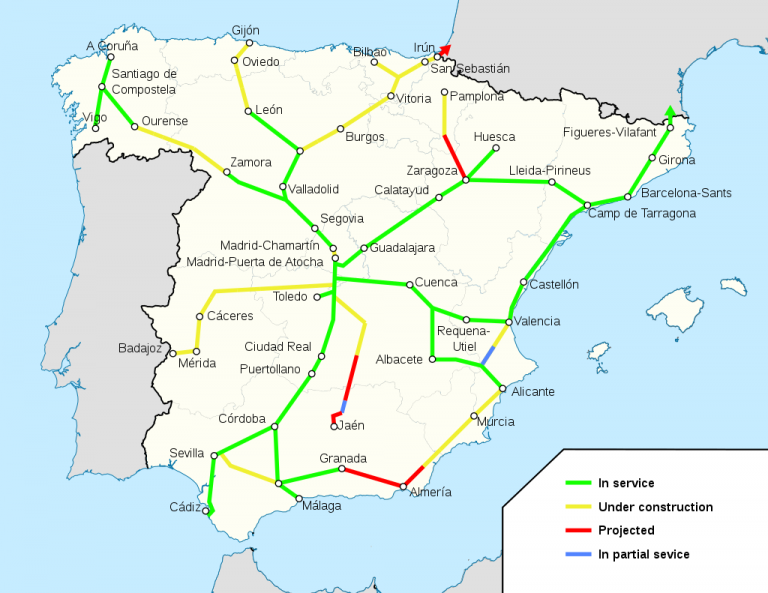The AIREF (fiscal Spanish authority) recently issued a report on investments in railway infrastructure in Spain over the last thirty years. The various media have coincided in the headlines of the issue with the sentence “AIReF asks for less investment to AVE compared to Cercanías and to improve planning.” While in Spain 55,888 million euros have been invested in the high-speed network in 30 years, of which 25.2% were paid for with European financing, the commuter network, which moves 90% of passengers in Spain, just received 3,600 million euros. This conclusion coincides exactly with the diagnosis made years ago by those of us who are dedicated to the defense of public transport. Impeccable.
The Spanish railway came out of its historic prostration with the construction of the AVE between Madrid and Seville in 1992. Not everyone knows that it is not a proper 100% AVE section, suitable for 300 km h, but rather in many sections the train does not exceed 200 km/h. In fact, this line was born as the conventional variant of Brazatortas, to eliminate the historic single-track bottleneck of Sierra Morena. But the first González government turned a classic fast rail variant into an even faster innovative alternative. Spain had entered the high-speed club and that gave the country an additional international prestige.
Then Aznar decided to concentrate rail investment, which had abundant non-refundable European financing from cohesion funds, on his government’s flagship infrastructure policy. But he concentrated it on the AVE because all the capitals of the peninsular province should be connected with Madrid. A criterion that can only be maintained under a territorial superpolitical approach, which no one else has done in Europe. But with the serious error of having omitted that railway policy must say something more than quickly connecting any corner of Spain with Madrid.
However, the delay in the Spanish railways was such that this generous production of high-speed tracks is going to be a profitable alternative in the medium term. Furthermore, AIReF confirms that its unit construction cost has been done at a very reasonable price. There has been no waste in the execution of these works. But the Spanish railway delay is also explained by the complicated peninsular orography, with a population concentrated over its coastline since at least 1850, at the time that railways were being built in Europe. For this reason, at the end of the 20th century, when the development of high speed began, Spain was the one among the large countries of Europe that suffered from the lowest per capita and km2 rail equipment. Despite having built the largest high-speed network in Europe, the Spanish unitary rail endowment continues being very low. In historical terms, what Spain is doing is making up the lost time since 1850. It should have done much better, but when in the next few years it decides, for the sake of the fight against the climate crisis, to prevent vehicles from using fossil fuels, in other words, the unfair competition suffered by the railroad from the plane and the car, then this new high-speed network will be absolutely essential.
Investing much more in suburban trains
On the other hand, when we claim that we must invest more in rail commuter lines and less in high speed, we are not saying that we must build many more kilometers of commuter lines, but rather that we must invest in improving the capacity of existing lines. And this means better signaling, more trains, with fully cadenced frequencies, better power supply and better stations, as well as some doubling. But new kilometers of commuter line sections are not requested. It is exactly the same as it has been done in Switzerland since 1990, the best European example of rail.
The two Catalan suburban lines pending of doubling are Barcelona-Vic and Arenys-Blanes. It must therefore be borne in mind that once all the necessary investments have been made to bring the Catalan proximity railway to the level that the Swiss currently enjoy, not a single km of line will have been increased, but the resulting network will be extremely powerful, capable of multiplying by three the 120 million annual travelers without any difficulty. The last railway plan presented by PTP for Catalonia, Objective 2024, is drawn up in this direction.
AIReF affirms that the global operations of high-speed rail lines are profitable in Spain, although investments are not recovered. I am in favor of not amortizing rail infrastructure in the accounting, in the same way that roads, hospitals or educational centers are not amortized, because their great social benefits are intangible. Public infrastructures represent the social, environmental and territorial policy of a state. A few weeks ago an interesting French report accounted for the enormous social benefits that the SNCF’s existence entails, doubling its accounting losses.
Overall, despite the goodwill of its editors, the AIReF report make mistakes on the classic short-term myopia of classical economics. The authors are not yet able to understand that we have entered an era in which we absolutely need zero-emission transport, and the only way to guarantee it is with the rail system.
Not long ago I issued an article in which I concluded that it was possible to replace all the peninsular internal flights with trains through the high-speed network. But to meet this challenge, we need a high-speed network that is widely deployed. If we also want to provide alternatives to other fossil fuel burners, cars and buses, we must also provide an effective regional service of good speed in all the Autonomous Communities (Spanish Regions) such as the one between Barcelona and Lleida and Girona, for example. Therefore, in view of the objective of 100% decarbonising Spanish transport, a modern rail network is essential, with a generous endowment in its infrastructure.
Today, the city of Barcelona has the urban railway infrastructure necessary for the city to function without cars. As long as the mayor wants, of course. But the infrastructure exists. The only missing element is to give it the frequency of circulation that FGCs enjoy today. However, on the Spanish scale, these railway infrastructures do not exist except in a few corridors.
It is true that the Spanish radio model has contributed to the territorial imbalance. It was a historical error of the Zapatero government to not denounce the high-speed radial railway model designed by Aznar, which only reinforced Madrid’s centripetalism. It was necessary to have incorporated the maritime corridors, which is where the Spanish population is concentrated, the Mediterranean, from Girona to Cádiz, and the Cantabrian. While the Mediterranean corridor is in an advanced state of construction, the Cantabrian corridor is only taking its first steps with the announcement of the improvement of the Santander-Bilbao line. Now, building railways in the interior of the so called “emptied Spain” has been simple, because there are no population centers to avoid or to integrate. Therefore, its unit cost of construction is proving so economical. Instead, building railways along the Spanish coastline, a territory that is practically an urban continuum and with a high population density, is already known to be extraordinarily complex and expensive. For example, the Lleida-Barcelona-French border AVE line has been the most expensive to build per km in all of Spain, far from the second section. Now, as seen in the image below, the Mediterranean corridor is well advanced. Now what is needed is to give it more capacity and speed.
We need to change the way in which we analyze the social performance of infrastructure investments.
Pau Noy Serrano, Associació per a la Promoció del Transport Públic (PTP, EPF member)



 Stay informed!
Stay informed!